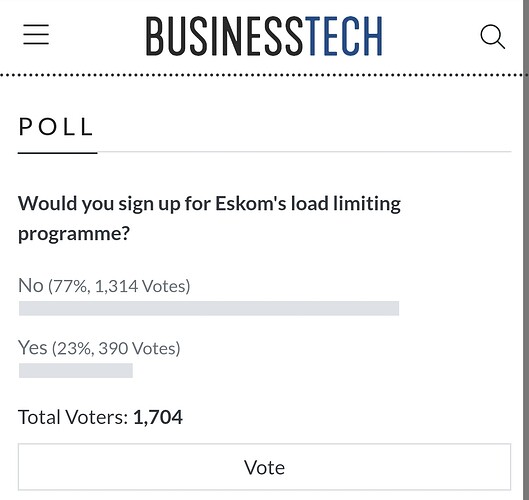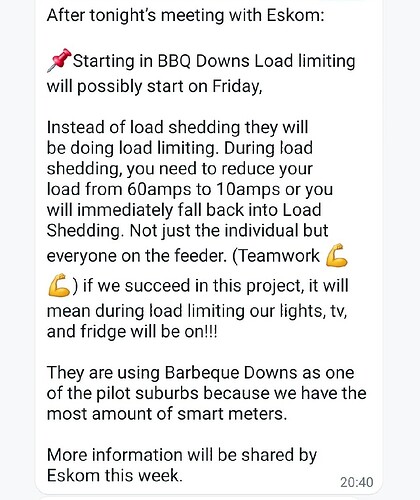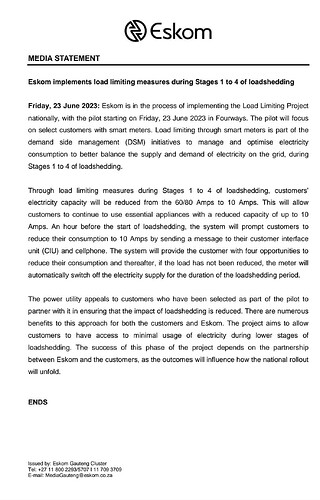The BusinessTech reader base says Nah.
Not a moment too soon: residents’ association in the suburb next door, and us as well. I think it’s going to be most of the Sandton—Midrand belt.
(I hope the “Teamwork ![]()
![]()
![]() !!!” will be followed by a Practical Guide to Adding Up Your Amps.)
!!!” will be followed by a Practical Guide to Adding Up Your Amps.)
Truth be told, IF this works, I would be suitably impressed.
I remember hearing about this the first time. The average social media response was: “I paid for the power, I will use it whenever I want to!”. Yeah…
I’m in two minds about this. I like the implementation. The option to make load-shedding more “local”, and shed the problem consumers rather than everyone, that I like. It seems more fair. Allowing people to have lights, TV, internet, excellent idea.
On the other hand… this gives Eskom more headroom, which in a perfect world will be used to fix things, but in a non-perfect world simply gives them room to do even less. The patch becomes a permanent fix.
Lovely usage for peak shaving. Would be nice if you could turn it off and on via modbus for while you are having load reduction.
To stop Victron to charge is easy, NodeRED.
To stop 'n geyser, I use Shelly.
If one can get the message from them in somewhere, one can pretty much switch all big loads off using IOT.
Personally, I would just switch off the main DB. We have solar.
But, for the man on the street who has no IOT even in place, yeah, it is a lot more effort.
Of course you can. You adjust the AC input current limit on the Multi, register 22. During load-reduction, simply set it to 10A. Afterwards, return it to the default (or just write a nice big number, like 1000, it will cap it at the max).
Can also do it via mqtt, or node-red. Or Home Assistant.
Is this the mqtt setting?: N/???/vebus/xxx/Ac/In/1/CurrentLimit
/Ac/ActiveIn/CurrentLimit is the one I am familiar with. I think the other one is just a copy. Reason for those two (on the Quattro there is also a number 2), is so you can see the current limit of the inactive input as well.
With the general public’s understanding of electricity, there is no way of this working without somehow enforcing this per household.
Most people have no grasp of what 10A means, much less how much they are using or what appliance is using what.
In concept I think this is great. I would be happy with a 5A connection 100% of the time if that means I don’t have to pay a connection fee. (actually I’d consider a 0A connection if that means no connection fee)
Well, perhaps a smart relay can be installed in households that effectively trips the house during certain timeslots if load exceeds 10A. People will learn quickly what appliance uses what.
Now the problem is like Izak mentions, the patch becomes the fix…
Must say, it makes me wonder:
- The people who pay for electricity, seem to be voting no for load reduction.
- The people who use electricity, and do not pay for it historically, can’t afford not to use electricity.
- The people who opt to install solar, get a break ito a max of R15k or whatnot, on panels only. It makes a huge dent, in this segment.
- Businesses that have to spend on other sources of power, cause an immense increase in prices of food and other goods.
- Farmers who must use electricity for their business, have an immense problem getting power to produce.
And Eskom is still pursuing this brainwave of cutting geysers … where most will insist on having hot water no matter what … that people will stand as one.
#DayZero efforts comes to mind … and that took an immense effort to get +4mil people to stand as one.
As already said this is all good and well in theory, but to me it sounds like a first world solution to a third world problem.
You will receive a SMS for this, a SMS few minutes before that, warning you about this. Eish the cell network is a bit slow today, the Eskom system is hanging, etc.
Perfect world where everyone have smart IOT electricity meters even smart IOT energy meters in the DB, then of course a reliable internet connection to the world to get the comms out, but unfortunately not in SA.
Isn’t this already how it works? If I understand correctly, they use their smart meters for this. The meter will apparently beep a few times if you go over, and then disconnect you for some time period.
Something like this requires little understanding from a user who does not know what 10A means. There is a little bar graph on the display, it blinks and beeps above a certain level, and you switch stuff off until it stops doing that. By day 3, you know you can maybe cook a kettle if nothing else is on… but no more.
If anything, this helps educate consumers who are so easily snake-oiled into buying stuff, learn by the seat of the pants what actually uses a lot of power ![]()
Sometimes we forget about the farmers. This passed weekend my uncle visited us, he mentioned with the last 2 or 3 weeks of minimal and no load shedding, it’s literally the second weekend this year he could leave the farm for a entire Saturday, even entire weekend, because no load shedding allowed him to pump enough water during the week, to run the irrigation pivots for long enough during the week so that he could have a off weekend.
They pump massive amounts of water, he has 4 or 5 pumps I think ranging around 30, 40 kW, then there’s the irrigation pivots as well, he said the stage 6 and 7 load shedding where it’s basically half a day without electricity was hell on them, not enough hours in a 24 hour day to get everything done.
Indeed. Which is where one of my own predictions comes in. The point where things really starts to go sideways for city people, is beyond level 8 (less than 12 hours a day). This is the point where the milk starts to go sour in the fridge. It’s a silly example, and nothing on the scale of farmers, but something I suspect will deeply aggravate ordinary folk in the same way a farmer is when he cannot pump water.
When we do get to Stage 7+, the milk in the city will pale in comparison to what is then crawling toward us.
The farmers must continue to run at all costs … which is possible … IF that was the focus.
Cities can take some “pain” … food production not so much.
If I was Eskom, would spend billions on getting farms off-grid to any extent it can be done … protect the food supply at all costs, whatever it takes.
It is “low hanging” fruit, to get farms “green” at a speed … feeding spare power back to the towns in the vicinity, lose it if there is surplus, so what.
THAT will take a chunk off Eskom, and secure the most crucial resource we have, after power.
And any and all criminal networks that even try to think of getting involved … shoot them on sight.
A message from your aspiring to become SA’s Benevolent Dictator Pressi.
.
Thinkin’ on that … all and every large retailer must increase food costs, and those costs are then to be passed on to farmers’ solar production so that all main food retailers effectively fund the solar installs on all the farms supplying them.
In essence, they are expanding their “security blanket”, not just protecting the retail part.
No farmers = no retail operations.
Said solar systems are tax-free, no import taxes, no VAT … at actual cost.
That will flood the market with solar systems for farms … it also makes it so not viable for any criminal activities.
Taxes can be gotten down the chain.
Protect food production at all costs, the only rule here.
I think this is correct. But people will learn and adapt.
My neighbours have some sort of inverter and battery solution. They don’t know how killowatt hour wotchamcallems it can provide, but they do know that during load shedding they don’t turn on lots of stuff in the kitchen and so on. They don’t know the numbers, but they have got an idea of where the limit is.
Also not so long ago people were checking their load shedding schedules and planning around those. So I have some hope that such a thing could work, even for people who don’t know an ampere from a volt.
The tricky case is things like dishwashers which most of the time don’t use a lot of juice, but a couple of times a cycle do.
If I look at my usage yesterday, most of the time I am under the 10A limit. By turning off the pool pump I can be under 10A nearly all the time. The one exception is a short peak up to 4kW. By turning the pool pump off I would be at about 3.3 kW. Still over, but only for a short time. That was, I think, the heat pump and the kettle at the same time.
We have a gas stove and an old fashioned kettle with a whistle. So we would resort to that during the stipulated hours to be safe.
COJ had a proposal a couple of years ago to reduce connection fees and give some financial relief for households that would except a 20A main breaker. But they added what I thought an unreasonable qualifier: You may not have any solar device other than a single solar geyser.
In the end they didn’t go ahead with it, but the proposal in the budget was interesting in the ways that it sought to incentivise careful consumption and bring some relief to poor residents. Then it went to vote and there was some horse trading and everybody ended up getting the NERSA-approved increase ![]()


